HashMap:
HashMap extends AbstractMap class and implements the Map interface. It contains the elements in key-value pair form. It does not maintain any order for its elements. It is not allowed duplicate keys. A HashMap can have only one null key and multiple null values.
- No order is maintained by the HashMap class.
- It is non-synchronized.
- Its initial default capacity is 16.
- Its load factor is 0.75.
HashMap class declaration:
public class HashMap<K,V> extends AbstractMap<K,V> implements Map<K,V>, Cloneable, Serializable
Where
- K: The type of keys maintained by the HashMap.
- V: The type of mapped values.
HashMap class Constructors:
| S.No. | Constructor | Description |
| 1 | HashMap() | It will create a default HashMap. |
| 2 | HashMap(Map<? extends K,? extends V> m) | It will create and initialize the hash map by using the elements of the given Map object m. |
| 3 | HashMap(int capacity) | It will create and initialize the capacity of the hash map to the given integer value, capacity. |
| 4 | HashMap(int capacity, float loadFactor) | It will create and initialize both the capacity and load factor of the hash map by using its arguments. |
HashMap class Methods:
| S.No. | Method | Description |
| 1 | void clear() | It will eliminate or delete all of the mappings from this map. |
| 2 | boolean isEmpty() | It will return true if this map contains no key-value mappings. |
| 3 | Object clone() | It will return a shallow copy of this HashMap instance: the keys and values themselves are not cloned. |
| 4 | Set entrySet() | It will return a collection view of the mappings contained in this map. |
| 5 | Set keySet() | It will return a set view of the keys contained in this map. |
| 6 | V put(Object key, Object value) | It will add an entry to the map. |
| 7 | void putAll(Map map) | It will add the specified map to the map. |
| 8 | V putIfAbsent(K key, V value) | It will add the specified value with the specified key in the map only if it is not already specified. |
| 9 | V remove(Object key) | It will delete or eliminate an entry for the specified key. |
| 10 | boolean remove(Object key, Object value) | It will eliminate or delete the specified values with the associated specified keys from the map. |
| 111 | V compute(K key, BiFunction<? super K,? super V,? extends V> remappingFunction) | It will compute a mapping for the specified key and its current mapped value (or null if there is no current mapping). |
| 12 | V computeIfAbsent(K key, Function<? super K,? extends V> mappingFunction) | It will compute its value using the given mapping function, if the specified key is not already associated with a value (or is mapped to null), and enters it into this map unless null. |
| 13 | V computeIfPresent(K key, BiFunction<? super K,? super V,? extends V> remappingFunction) | To compute a new mapping given the key and its current mapped value if the value for the specified key is present and non-null. |
| 14 | boolean containsValue(Object value) | It will return true if some value equal to the value exists within the map, else return false. |
| 15 | boolean containsKey(Object key) | It will return true if some key equal to the key exists within the map, else return false. |
| 16 | boolean equals(Object o) | It will compare the specified Object with the Map. |
| 17 | void forEach(BiConsumer<? super K,? super V> action) | It will perform the given action for each entry in the map until all entries have been processed or the action throws an exception. |
| 18 | V get(Object key) | It will return the object that contains the value associated with the key. |
| 19 | V getOrDefault(Object key, V defaultValue) | It will return the value to which the specified key is mapped, or defaultValue if the map contains no mapping for the key. |
| 20 | boolean isEmpty() | It will return true if the map is empty; returns false if it contains at least one key. |
| 21 | V merge(K key, V value, BiFunction<? super V,? super V,? extends V> remappingFunction) | It will associate the specified key with the given non-null value if it is not already associated with a value or is associated with null. |
| 22 | V replace(K key, V value) | It will replace the specified value for a specified key. |
| 23 | boolean replace(K key, V oldValue, V newValue) | It will replace the old value with the new value for a specified key. |
| 24 | void replaceAll(BiFunction<? super K,? super V,? extends V> function) | It will replace each entry’s value with the result of invoking the given function on that entry until all entries have been processed or the function throws an exception. |
| 25 | Collection<V> values() | It will return a collection view of the values contained in the map. |
| 26 | int size() | It will return the number of entries on the map. |
HashMap example:
HashMapTest.java
import java.util.HashMap; import java.util.Iterator; import java.util.Map; import java.util.Set; /** * This class is used to show the HashMap functionality. * @author w3schools */ public class HashMapTest { public static void main(String args[]){ //Create HashMap object. Map hashMap = new HashMap(); //Add objects to the HashSet. hashMap.put(4, "Roxy"); hashMap.put(2, "Sunil"); hashMap.put(5, "Sandy"); hashMap.put(1, "Munish"); hashMap.put(3, "Pardeep"); //Print the HashMap object. System.out.println("HashMap elements:"); System.out.println(hashMap); //Get iterator Set set=hashMap.entrySet(); Iterator iterator=set.iterator(); //Print the HashMap elements using iterator. System.out.println("HashMap elements using iterator:"); while(iterator.hasNext()){ Map.Entry mapEntry=(Map.Entry)iterator.next(); System.out.println("Key: " + mapEntry.getKey() + ", " + "Value: " + mapEntry.getValue()); } } } |
Output:
HashMap elements: {1=Munish, 2=Sunil, 3=Pardeep, 4=Roxy, 5=Sandy} HashMap elements using iterator: Key: 1, Value: Munish Key: 2, Value: Sunil Key: 3, Value: Pardeep Key: 4, Value: Roxy Key: 5, Value: Sandy |
Example: Different ways to insert elements:
import java.util.*; public class HashMapExample{ public static void main(String args[]){ HashMap<Integer,String> hm=new HashMap<Integer,String>(); System.out.println("The initial list of elements:: "+hm); hm.put(200,"A"); hm.put(201,"B"); hm.put(202,"C"); System.out.println("After invoking the put() method:: "); for(Map.Entry m:hm.entrySet()){ System.out.println(m.getKey()+" "+m.getValue()); } hm.putIfAbsent(203, "D"); System.out.println("After invoking the putIfAbsent() method:: "); for(Map.Entry m:hm.entrySet()){ System.out.println(m.getKey()+" "+m.getValue()); } HashMap<Integer,String> map=new HashMap<Integer,String>(); map.put(204,"E"); map.putAll(hm); System.out.println("After invoking the putAll() method:: "); for(Map.Entry m:map.entrySet()){ System.out.println(m.getKey()+" "+m.getValue()); } } } |
Output:

Example: Different ways to remove elements:
import java.util.*; public class HashMapExample{ public static void main(String args[]) { HashMap<Integer,String> map=new HashMap<Integer,String>(); map.put(200,"A"); map.put(201,"B"); map.put(202,"C"); map.put(203, "D"); System.out.println("The initial list of elements:: "+map); //key-based removal map.remove(200); System.out.println("The updated list of elements:: "+map); //value-based removal map.remove(201); System.out.println("The updated list of elements:: "+map); //key-value pair based removal map.remove(202, "C"); System.out.println("The updated list of elements:: "+map); } } |
Output:

Example: Different ways to replace elements:
import java.util.*; public class HashMapExample{ public static void main(String args[]){ HashMap<Integer,String> hm=new HashMap<Integer,String>(); hm.put(200,"A"); hm.put(201,"B"); hm.put(202,"C"); System.out.println("The initial list of elements::"); for(Map.Entry m:hm.entrySet()) { System.out.println(m.getKey()+" "+m.getValue()); } System.out.println("The updated list of elements::"); hm.replace(202, "c"); for(Map.Entry m:hm.entrySet()) { System.out.println(m.getKey()+" "+m.getValue()); } System.out.println("The updated list of elements::"); hm.replace(201, "B", "b"); for(Map.Entry m:hm.entrySet()) { System.out.println(m.getKey()+" "+m.getValue()); } System.out.println("The updated list of elements::"); hm.replaceAll((k,v) -> "a"); for(Map.Entry m:hm.entrySet()) { System.out.println(m.getKey()+" "+m.getValue()); } } } |
Output:

Next Topic: LinkedHashMap in java with example.
Previous Topic: LinkedList in java with example.